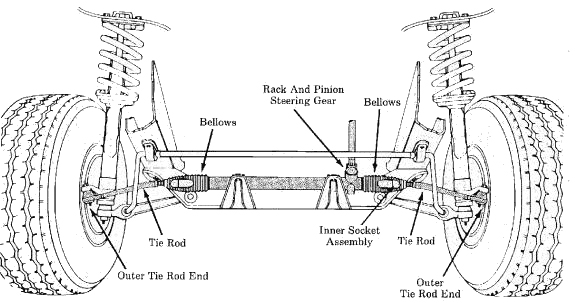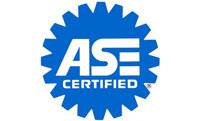Why replace
rack-and-pinion steering rather than rebuild it

Overhauling a power rack is not a
job for the novice. Special tools are required to remove and
install internal seals. The tools are expensive and may not
be cost justified for a shop that only does an occasional
rack. For a do-it-yourselfer, the tools could end up costing
as much as a new or remanufactured rack.
It is tricky to get seals properly positioned. If a seal
slips or is damaged during installation, the rack will leak.
For that reason alone, many professional mechanics won't
waste their time trying to rebuild questionable racks.
Operating pressures within a power rack generally do not
exceed 100 psi when the wheels are in the straight-ahead
position. In an easy turn, the pressure can increase to as
much as 300 psi and it goes up to 700 psi in a tight turn.
The highest pressures are usually encountered when parking.
If the wheels are up against a curb or if the steering wheel
is turned hard against the stop, internal pressures can
climb to 700 to 1,400 psi. This is why anybody who overhauls
a rack better make sure the seals don't leak.
Time is another important factor to the professional
installers. Anything that makes their job easier and faster
is money in their pocket. If given a choice, most avoid
doing repairs the old fashioned way because overhauling
certain components in the shop slows them down and takes too
much time. That's why many components (like starters,
alternators, front-wheel drive driveshaft assemblies, even
brake calipers) are often replaced with new or
remanufactured units rather than overhauled in the shop. The
same is true for racks.
Time is money... and at $40 per hour it doesn't take long
for a mechanic's time to add up. By the time a mechanic
spends $25 to $30 for a seal kit and several hours
overhauling a rack (assuming it can be overhauled), he can
end up spending as much of his customer's money as if he had
bought a replacement rack in the first place.
Another reason why installers and do-it-yourselfers do not
rebuild their own racks is because some racks are not
rebuildable - at least not with a seal kit alone. If the
teeth in the center of the rack are worn or damaged, a
replacement rack bar can run $100 to $150.
If the housing is worn, distorted, cracked or otherwise
unusable, a new housing can cost upwards of $125. If the
control valve is bad, it will cost $150 to $250 to replace -
if you can find the parts. Individual component parts for
racks are not readily available in the aftermarket because
everyone knows it is cheaper and smarter to go with a new or
remanufactured rack if the original rack needs to be
overhauled.
Rebuilders can often salvage worn aluminum spool valve
housings by boring out the housings and installing a
stainless steel sleeve. The sleeve not only restores
tolerances, but also prevents the wear problem from
reoccurring. In that respect, a remanufactured rack may
actually be better than the original. Most rebuilders also
pressure test their racks after reassembly to make certain
they function correctly and do not leak.
One mistake installers should avoid when replacing a rack is
not flushing out the power steering pump and lines to remove
all traces of old fluid. Flushing is a must because it
removes contaminants that could ruin the replacement rack.
The system also needs to be purged of air by cycling the
steering slowly back and forth until there are no more air
bubbles in the fluid.
Related items that may also need replacing include rack
mounts and steering input shaft coupling. If the coupling
donut is deteriorating with age, it needs to be replaced.
Metal swivel couplings also need to be checked for rust and
binding. Do not forget to include new power steering fluid
(follow manufacturer recommendations as to the proper type
of fluid).
OneStop Auto Shop
Call Today for
all of your Auto Repairs
and Maintenance
in Hollywood, Ca.!
(323) 227-9999
|























